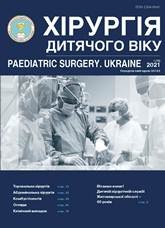Bouveret syndrome (clinical case)
DOI:
https://doi.org/10.15574/PS.2021.70.74Keywords:
Gallstone disease, acute intestinal obstruction, Bouveret syndromeAbstract
Gallstone disease is one of the most common surgical nosologies, which tends to increase steadily. More than 2.5 million cholecystectomy surgeries are performed annually in the world: in European countries – from 45 to 80 thousand, in the United States – more than 700 thousand choledocholithiasis with the development of mechanical jaundice. Diagnosis of these complications in most cases is not difficult, and the provision of surgical care is standardized. Bouvet’s syndrome (syn. Acute biliary ileus, Gallstone ileus) is a very rare complication of gallstone disease and is caused by the development of inflammatory degenerative-dystrophic changes between the gallbladder and the duodenal wall, leading to the formation of fistulas through which -intestinal tract with the development of obstruction. However, it should be noted that only in 7–10% of cases, the formed fistula can cause the migration of stones and the development of intestinal obstruction.
By 2008, only about 300 cases of the syndrome had been described in the world literature. Patients with a long history of stone disease, frequent episodes of exacerbation of cholelithiasis, female gender, old age are the main risk factors for Bouvere syndrome. Compared to other types of mechanical obstruction, the frequency of biliary ileus is only 1–4% and can reach 24% in people over 70 years. The complexity of the diagnosis is due to the nonspecificity of the initial manifestations, comorbidity of patients, late treatment. Postoperative mortality in acute calculous cholecystitis ranges from 0.28% to 3.01% (on average in Ukraine 0.94–0.81%), and in Bouvere syndrome can reach 24%. The main direct causes of death are bleeding, perforation, acute pancreatitis, severe dyselectrolyte disorders. The possibility of widespread use of computed tomography and magnetic resonance imaging greatly simplifies the diagnostic search. However, unfortunately, preoperative diagnosis of the syndrome is achieved only in a quarter of patients. Minimally invasive methods, given the growth of scientific publications and personal experience, can be successfully used to correct this pathology as a final method. A literature review of the etiology, pathogenesis, clinical manifestations, prevalence, methods of diagnosis and treatment of Bouvet syndrome is presented.
Clinical case (short description). Presented own clinical observation of Bouvere syndrome in a patient hospitalized in the surgical department of the KNP «Regional Clinical Hospital named after O.F. Gerbachevsky» with the phenomena of duodenal immobility and long history of stone-bearing. Consecutive use of endoscopic and instrumental imaging methods allowed accurate diagnosis, and the use of laparoscopic access made it possible to perform minimally invasive correction of pathology in this patient.
Conclusions. Gallstone disease is one of the most common surgical pathologies. Bouvere syndrome is a rare complication of the latter. Clinical symptoms are less specific, so the use of additional instrumental examinations allows accurate preoperative diagnosis. Due to the low efficiency of endoscopic methods of correction surgery is the main tool. The increase in scientific publications on the use of laparoscopic and video-assisting techniques makes it possible to argue about the relatively high efficiency of the latter in the correction of this pathology.
The research was carried out in accordance with the principles of the Helsinki Declaration. The informed consent of the patient was obtained for conducting the studies.
The authors declare no conflicts of interests.
References
Ariche A. (2000). Gastric outlet obstruction by gallstone: Bouveret syndrome. Scand J Gastroenterol. 35 (7): 781-783. https://doi.org/10.1080/003655200750023480; PMid:10972185
Ariol D. (2008). Intermittent gastric outlet obstruction due to a gallstone migrated through a cholecysto-gastric fi stula: а new variant of Bouveret's syndrome. World J Gastroenterol. 14: 125-128. https://doi.org/10.3748/wjg.14.125; PMid:18176974 PMCid:PMC2673376
Donati M. (2010). The surgical treatment of a rare complication: gallstone ileus. Annali Italiani di Chirurgia. 81: 57-62.
Doycheva I. (2009). Bouveret's syndrome: case report and review of the literature. Gastroenterology Research and Practice: 4. https://doi.org/10.1155/2009/914951; PMid:19360112 PMCid:PMC2666152
Dudnyk VM, Furman VH. (2017). Zhovchnokamiana khvoroba u ditei, khvorykh na spadkovumikrosferotsytarnu hemolitychnu anemiiu. Cholelitihiasis in children with hereditary microspherocytosis. Bulletin of the Vinnytsia National Medical University. 2 (21): 410-413.
Kalwaniya DS. (2015). A rare presentation of gastric outlet obstruction (GOO) - The Bouveret's syndrome. Annals of Medicine and Surgery. 4: 67-71. https://doi.org/10.1016/j.amsu.2015.02.001; PMid:25830020 PMCid:PMC4355450
Mavroeidis VK. (2013). Bouveret Syndrome The rarest variant of gallstone ileus: A case report and literature review. Case Reports in Surgery: 6. https://doi.org/10.1155/2013/839370; PMid:23864977 PMCid:PMC3707284
Mishra A. (2013). Bouveret Syndrome: A Case report and review. Journal of gastrointestinal & digestive system. 3: 3. https://doi.org/10.4172/2161-069X.1000133
Rippoles T. (2001). Gallstone ileus: increased diagnostic sensitivity by combining plain film and ultrasound. Abdominal Imaging. 26: 401-405. https://doi.org/10.1007/s002610000190; PMid:11441553
Rossetti A. (2014). Gallstone ileus in an already cholecystectomized patient. Int J Case Rep Images. 5 (6): 453-455. https://doi.org/10.5348/ijcri-201456-CL-10044
Sica G. (2005). Laparoscopic treatment of Bouveret's syndrome presenting as acute pancreatitis. JSLS. 9 (4): 472-475.
Tchercansky A. (2019). Laparoscopic management of Bouveret's syndrome after failed endoscopic approach. Case Reports in Surgery: 4. https://doi.org/10.1155/2019/7067240; PMid:31346486 PMCid:PMC6636471
Tyvonchuk OS. (2020). Laparoskopichne vydalennia konkrementa pry syndromi Bouveret Laparoscopic publication of specific Bouvere syndromes. Klinichna khirurhiia. 87 (34): 102-104. https://doi.org/10.26779/2522-1396.2020.3-4.102
Downloads
Published
Issue
Section
License
The policy of the Journal “PAEDIATRIC SURGERY. UKRAINE” is compatible with the vast majority of funders' of open access and self-archiving policies. The journal provides immediate open access route being convinced that everyone – not only scientists - can benefit from research results, and publishes articles exclusively under open access distribution, with a Creative Commons Attribution-Noncommercial 4.0 international license(СС BY-NC).
Authors transfer the copyright to the Journal “PAEDIATRIC SURGERY.UKRAINE” when the manuscript is accepted for publication. Authors declare that this manuscript has not been published nor is under simultaneous consideration for publication elsewhere. After publication, the articles become freely available on-line to the public.
Readers have the right to use, distribute, and reproduce articles in any medium, provided the articles and the journal are properly cited.
The use of published materials for commercial purposes is strongly prohibited.

